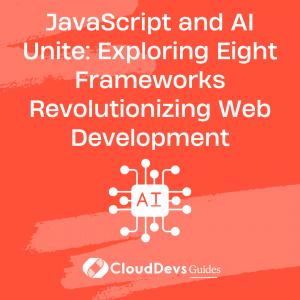JavaScript and AI Unite: Exploring Eight Frameworks Revolutionizing Web Development
Artificial Intelligence (AI) is rapidly transforming various sectors, from healthcare to entertainment, logistics, and education. Its impact on web development is increasingly notable, particularly through the integration of AI capabilities within diverse development frameworks. This shift underscores the growing need to hire AI developers capable of navigating these transformations.
Prominent among these frameworks are those based on JavaScript, renowned for its universal application in web development. It provides a dynamic platform for building AI-powered solutions, driving everything from user-interface transitions to sophisticated single-page applications. In this article, we will delve into several JavaScript frameworks used in AI development and highlight some real-world applications.
TensorFlow.js
TensorFlow.js (https://www.tensorflow.org/js) is one of the most powerful libraries for machine learning (ML) in JavaScript. Developed by Google, it allows developers to define, train, and run machine learning models entirely in the browser, using JavaScript and a high-level layers API, or its low-level, linear algebra-focused operations API.
For example, let’s look at Speech Commands, a pre-trained model provided by TensorFlow.js for speech recognition. This model can recognize spoken commands and works entirely in the browser. The Speech Commands model has various applications, such as voice-controlled games or interactive voice-responsive websites.
Another application of TensorFlow.js is PoseNet, a model that can estimate human poses in real-time. PoseNet can be used in virtual fitness coaching applications where it can analyze and give feedback on the user’s exercise form. It can also be used in security applications, detecting intruders based on abnormal human poses.
Synaptic.js
Synaptic.js (https://github.com/cazala/synaptic) is another powerful JavaScript library for building neural networks. It provides developers with tools to design, train, and deploy neural networks, which form the core of many AI applications.
A brilliant use case of Synaptic.js is “Brain Browser”, a machine learning application developed by the Australian software company, Axon. Brain Browser is an online tool that allows neurologists to view brain images and diagnose neurological disorders. By using Synaptic.js, Axon built a model to predict a patient’s likelihood of having a neurological disorder based on their brain scan images.
Brain.js
Brain.js (https://brain.js.org/#/) is a simple and flexible JavaScript library for neural networks. It provides a series of neural network implementations that can run both in the browser and on Node.js.
An interesting application of Brain.js is in Natural Language Processing (NLP), as demonstrated by the team at CoCoHub. They used Brain.js to develop a chatbot model that understands and responds to the user’s text input in a more human-like manner. It uses Brain.js’s neural networks to understand sentence structures and analyze user sentiment.
ml5.js
ml5.js (https://ml5js.org/) is a high-level machine learning library that provides access to machine learning algorithms and models in the browser, built on top of TensorFlow.js. With its user-friendly API, ml5.js makes it easy to create interactive AI-powered applications.
One notable implementation of ml5.js is the “Teachable Machine” project developed by Google’s Creative Lab. The project allows anyone to train a machine learning model in the browser, without any coding, and use it to recognize images, sounds, or poses. This empowers individuals with no prior coding or machine learning experience to experiment with AI technology.
Keras.js
Keras.js (https://github.com/transcranial/keras-js) is a library that allows you to run machine learning models in the browser. The models are trained using Python’s Keras library and can then be run in the browser using Keras.js.
An example of an application using Keras.js is the “Emotion Recognition” system developed by Affectiva. This system uses machine learning models to analyze facial expressions in videos and identify the person’s emotional state. The models were trained using Keras and deployed in a web application using Keras.js, allowing for real-time emotion analysis directly in the user’s browser.
Danfo.js
Danfo.js (https://danfo.jsdata.org/) is a JavaScript library inspired by the popular Python data analysis library, Pandas. It provides structures for handling and manipulating structured data, which is crucial in AI and machine learning where large amounts of data need to be processed and analyzed.
A use case of Danfo.js is in “Data Explorer“, a data analysis tool developed by Zillow. This tool uses Danfo.js to manage and analyze housing market data, allowing users to find trends and patterns that can help them make informed decisions when buying or selling a property.
WebDNN
WebDNN (https://github.com/mil-tokyo/webdnn) is a DNN (Deep Neural Network) execution framework which is optimized for web browsers. It dramatically accelerates DNN execution by utilizing WebGL computing and WebAssembly.
An example use of WebDNN is in “Sketch Simplification”, an online tool developed by Adobe. This tool uses deep learning models to automatically simplify user’s sketches, turning rough sketches into clean line art. The models were trained offline and then deployed in the web application using WebDNN, allowing for real-time sketch simplification directly in the user’s browser.
Compromise
Compromise (https://compromise.cool/) is a fast, lightweight NLP library for JavaScript. It’s designed to extract, parse, and manipulate the English language and find semantic meaning in the text.
Take the case of “Headliner”, an application developed by News UK. Headliner uses Compromise to scan news articles and identify key names, dates, places, and other important information. It then automatically generates concise headlines for the articles. This AI-powered headline generation helps News UK’s editorial team save time and streamline their work process.
Wrapping Up
JavaScript frameworks are catalyzing a new era in web development, enabling AI-driven applications that redefine the boundaries of possibility. To leverage these potentials, businesses are looking to hire AI developers well-versed in both AI principles and JavaScript frameworks. These professionals ensure ethical AI applications, fostering an ecosystem that respects privacy, fairness, and transparency. Whether you’re an established business or a startup, harnessing AI’s power is crucial for a future-proof digital strategy.
Table of Contents









